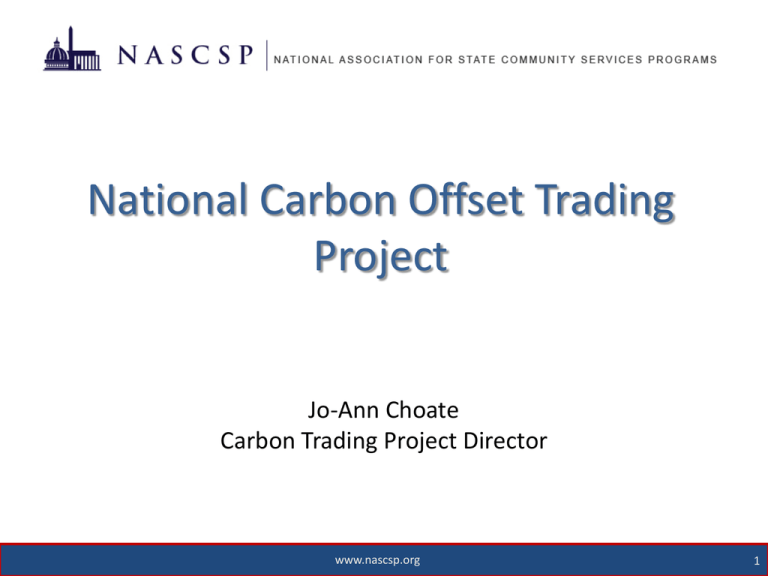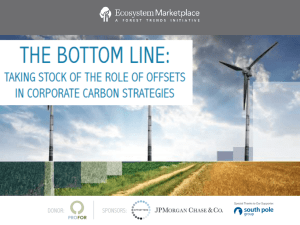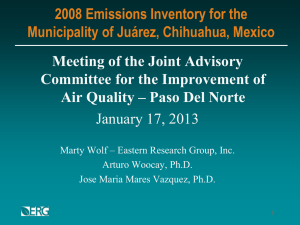WAP Carbon Trading Project - Weatherization Assistance Program
advertisement

National Carbon Offset Trading Project Jo-Ann Choate Carbon Trading Project Director www.nascsp.org 1 Overview • New initiative to implement a National Carbon Trading Project. • NASCSP is developing a national framework to measure carbon emission reductions from weatherization activities and sell carbon offsets in the voluntary carbon markets in compliance with the Verified Carbon Standard (VCS). • Purposes: • Leverage additional funding for WAP • Assist States to improve quality of services • Expand the WAP network’s expertise beyond the low income community www.nascsp.org 2 What is Carbon? • The burning of fossil fuels leads to carbon emissions, green house gases that absorb and emit radiation in the atmosphere. • Carbon emissions come in many forms, including the pollution from single and multi-family dwelling releasing CO2 in the atmosphere. • 40% of energy used in the US goes to power commercial and residential buildings. • Half of that (20% of total) is for space heating and cooling. www.nascsp.org 3 Benefits of Weatherization • • • • Reduces pollution in the atmosphere Reduces dependence on fossil fuels Reduces the cost of energy bills Creates an opportunity to expand weatherization funds by selling carbon offsets. • Creates and sustains quality jobs. www.nascsp.org 4 What is an Offset? • It is a way for a polluter to satisfy carbon emissions reduction obligations without reducing carbon emissions. • It is a way for a buyer (such as Chevy, universities, etc.) to help reduce their carbon emissions . • It is a way for a buyer to support a carbon emissions reduction projects for social purposes, etc. www.nascsp.org 5 The Global Carbon Market • Total Value in 2008: $126 billion. • The Compliance Market was $120 billion in 2008 – Kyoto Protocol including the Clean Development Mechanism (CDM) EU Emissions Trading Scheme. • The Voluntary Market was $705 million in 2008 and projected to be $850 million in 2009. • If the US implements a cap-and-trade system, the voluntary market could reach $300 billion annually. www.nascsp.org 6 How Do States Start? • States can choose to work with NASCSP. • NASCSP will help states establish a process and streamline the cost of implementing a carbon project by: • Assisting states in establishing standards to identify carbon. • Assisting States in ensuring data quality and monitoring. • Ensuring savings from activities are proven. • Assisting states with development of a Project Description. • Working with states to keep cost low (Note: there will be cost for each state to participate but at a very minimum amount to implement the project and maintain the data). www.nascsp.org 7 NASCSP Role • • • • • • • Identify Scope and Plan for Project Identify and Manage Carbon Data Write Project Description Validate Project Description Verify Offsets Register and Sell Offsets Provide Carbon funds back to each State. www.nascsp.org 8 Current Activities • To date, 17 states have signed up to participate in the program. • NASCSP staff has begun the process of setting up systems to review documents and questionnaires provided from each state. • Developing the first Project Description (PD). • Developing training webinars for participating states . www.nascsp.org 9 Questions? Jo-Ann L. Choate Carbon Trading Project Director jchoate@nascsp.org Phone: 202.624-7859 Cell: 207-620-0209 Eric Stam Carbon Trading Research Analyst estam@nascsp.org Phone 202.624-8828 www.nascsp.org 10







